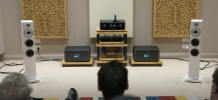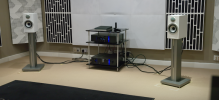Steve Dallas
Major Contributor
The listening window is only valid if you're "listening" at 0-degs (directly on the tweeter axis).
This applies to speakers like the Genelec monitors:
View attachment 248681
And Revel loudspeakers:
View attachment 248682
Whereas, with B&W speakers, you're expected to "adjust" the amount of toe-in in order to adjust the relative brightness of the loudspeaker.
So, if you set up your B&W's in the same way as you would a Revel/Genelec, and you interpret the measurements as you would a Revel Genelec (i.e. assuming the "listening window" is usable when speakers are not aimed directly at you), then you will conclude that B&W's sound bright and the measurement prove it (which is just not the case, when set up properly).
It just goes to show that you can't simply "eyeball" a series of polar FR measurements and predict the in-room response when the MLP is not at 0-degs with respect to the tweeter axis.
This is a MMM measurement of stereo pink noise of my B&W 802D's using a calibrated umik-1. As you can see, it follows a fairly smooth decreasing response with presence/BBC dip at 2-3kHz. This B&W set up in my living room sounds far better than the Genelec 8351B set up in my office. In fact, I use PEQ on my 8351B's to approximate the B&W curve! Sorry, but I prefer the way my music sounds on speakers with that dip, and so do a lot of people.
View attachment 248680
No. The listening window is an average of measurements (on-axis plus typically 4 to 8 off-axis mic positions) that attempts to describe how a speaker will sound to most people at typical (off-axis) seating positions. It is a crude approximation of the predicted in-room response. It is not what you describe at all.
Your measurement looks pretty problematic to me. Research shows people generally like a 10dB downward slope in-room. Yours is significantly more sloped than that. Also, we if assume <500Hz is heavily room influenced and draw a trend line (black) on the rest, we do not have an even response. We have a hole in the upper mids and brightness, just as the LW predicts. We have a tilted and squashed Batman.
If we use the green trend line, which is what I think you want us to use, we have a more reasonable slope, but an even bigger midrange dip. And still Batman.
My brain follows the black line as it zeroes in on midrange. Yours may follow the green line, if you are accustomed to not having midrange. I would not like the sound of your setup. I can tell this just by looking at the measurement. I also know this from personal experience with a lot of B&W speakers over the past 25 years. You may truly like this sound, and that is, of course, fine.
B&W speakers are not different. They are governed by physics just like all other speakers. And their response can be predicted with great accuracy from their measurements just like all other speakers. Your measurement actually proves the opposite of your argument. Your measurement follows the LW to the limit of its predictive usefulness. The LW has done its job in this case.
[EQing Genelecs to sound like B&Ws sounds like a huge waste of good Genelecs!]
Last edited:







